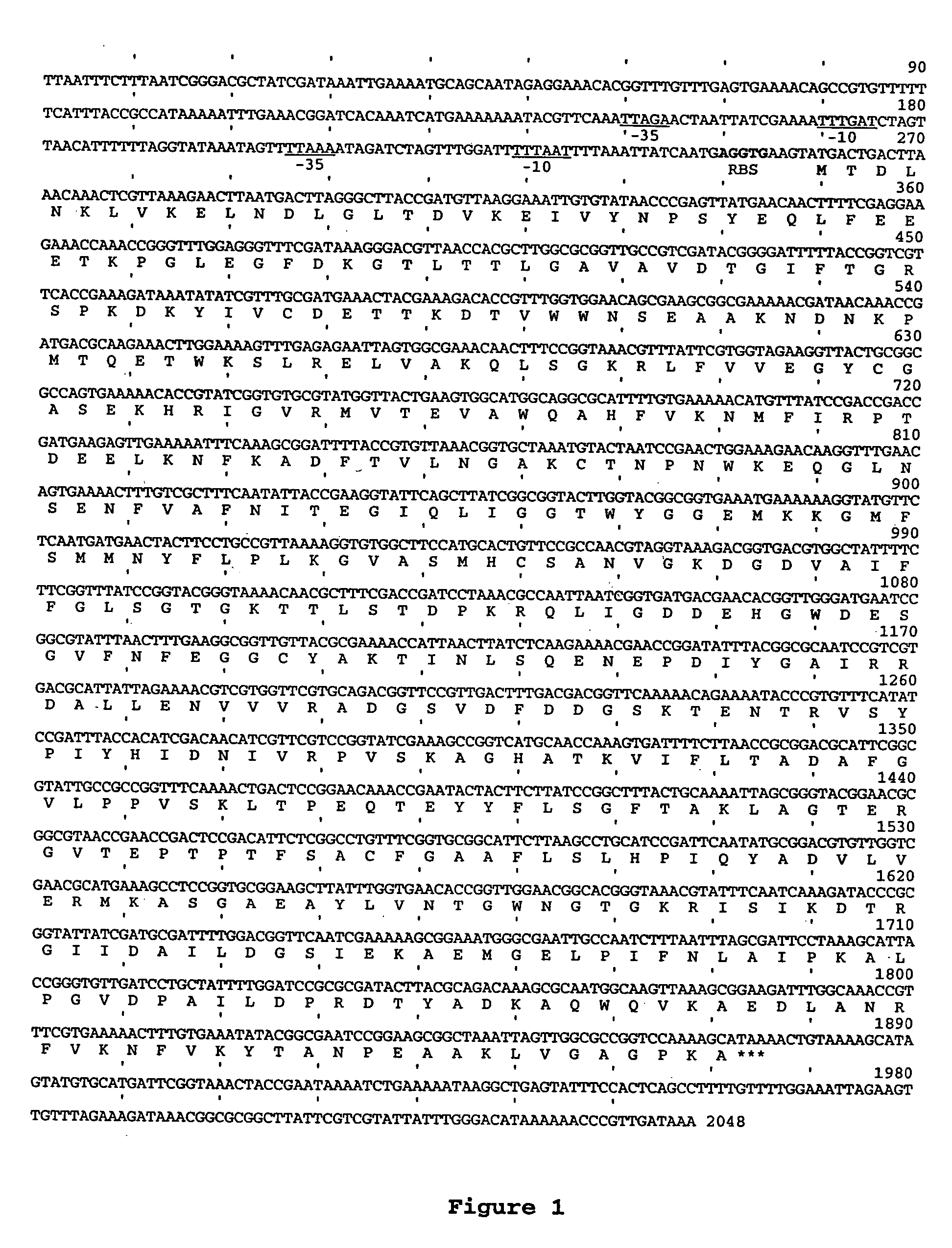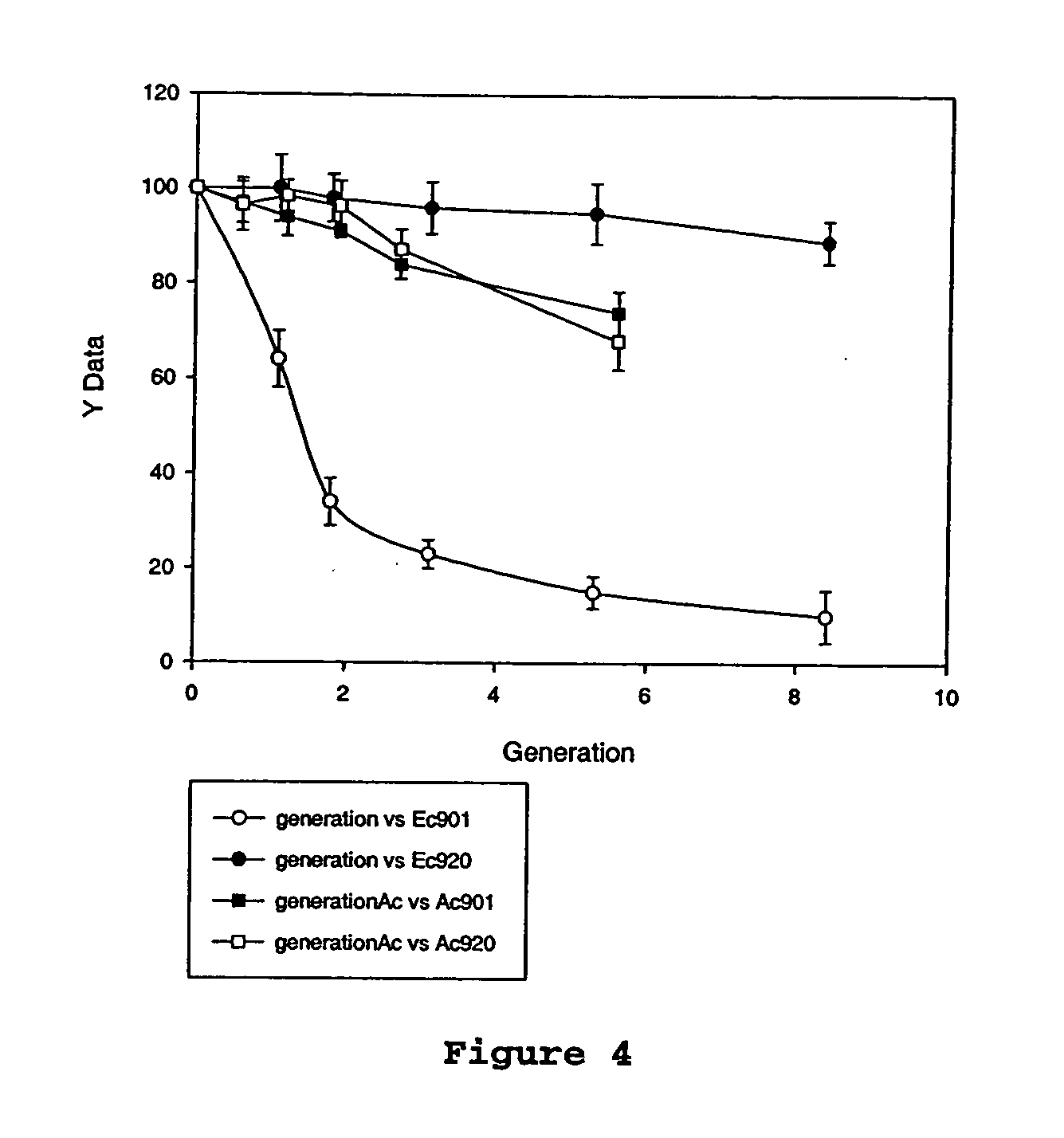Actinobacillus succinogenes shuttle vector and methods of use
a technology of plasmid vectors and bacteriostatic bacteria, applied in the field of plasmid vectors, can solve the problems of not yet a means for constructing recombinant i>a. succinogenes, no genetic tools have been tested or developed that could be used for engineering i>a, and no engineered strains surpassed i>a. succinogenes for succinate production
- Summary
- Abstract
- Description
- Claims
- Application Information
AI Technical Summary
Benefits of technology
Problems solved by technology
Method used
Image
Examples
example 1
[0057] Bacterial strains and plasmids used in this study are listed in Table 1.
TABLE 1PlasmidRelevant characteristicsReferencespCR ™ IITOPO TA cloning vectorInvitrogen,Carlsbad, CApCR2.1TOPO TA cloning vectorInvitrogenpUC19AmpR, lacZα, ColE1Invitrogenmulticopy cloning vectorpProEx-1AmpR, ColE1 multicopy cloning[Bolivar, 1978vector#3323]pBR325AmpR, CmR, TetR, ColE1 cloningLaboratoryvectorcollectionpGZRS-19pGZRS-1 replicon, AmpR (Tn3),(30)replicates in Aple, Phae, Aact,Replicates in E. coli,pUC18 / 19 multiple cloning site,lacZα-complementationpGZRS-30pGZRS-1 replicon, KmR (Tn903),(30)CmR (Tn9)UB214Mannheimia haemolytica pMHT1(17)replicon, TetRpLGZ901pGZRS-19 derivative, A. succinogenesThis studypckA promoterpLGZ902pGZRS-19 derivative, A. succinogenesThis studypckA genepLGZ903pGZRS-19 derivative, E. coli lacZαThis studyunder control of the A. succinogenespckA promoterpLGZ920pGZRS-19 derivative, A. succinogenesThis studypckA promoter, pGZRS-1 and ColE1repliconspLGZ921pLGZ920 derivative...
example 2
[0059] Antibiotic minimum inhibitory concentrations. To determine the sensitivity of A. succinogenes 130Z to antibiotics, the growth of A. succinogenes 130Z was tested in medium A (liquid medium) containing a series of antibiotics commonly used in bacteriology. Antibiotics and antibiotic concentrations used are listed in Table 2. One ml of 130Z preculture was inoculated into 9 ml of medium A containing each antibiotic and incubated at 37° C. for 7 days. Cell growth was followed by measuring OD660.
TABLE 2Antibiotics and antibiotic concentrations used in this study.Concentration usedConcentrationsin plates aftertested in liquidtransformationAntibioticcultures (μg / ml)(μg / ml)Ampicillin5, 10, 25, 5025Chloramphenicol1, 2.5, 5, 10 2.5Tetracyclin5, 10, 20, 3010Erythromycin5, 10, 2010Streptomycin30Not usedKanamycin50Not used
[0060] Resistance of A. succinogenes to antibiotics. Growth of A. succinogenes 130Z was tested in the presence of antibiotics at the concentrations listed in Table 2. A...
example 3
[0061]succinogenes 130Z (ATCC 55618) was used as the host strain. One hundred ml of actively growing cells in TS broth (OD660 of 0.3) were chilled on ice and harvested by centrifugation at 4,000×g for 10 minutes at 4° C. Cells were washed twice with 5 ml of ice-cold 15% glycerol and resuspended in 0.2 ml of ice-cold 15% glycerol. Fifty microliters (μl) of this cell suspension was mixed with 0.5-1 microgram (μg) plasmid in a chilled, 2.0 mm Gene pulser cuvette (BioRad, Richmond, Calif.). Electroporation was performed at 2.5 kV, 200 Ω, and 25 μF. One milliliter (ml) of TS broth was immediately added to the electroporated cells. The suspension was incubated for 1 hour (hr) at 37° C. and then spread (under air) on TS agar plates containing ampicillin, chloramphenicol, or tetracycline (concentrations listed in Table 2). Plates were incubated in an anaerobic jar under CO2 atmosphere at 37° C. for 24-48 hr. A. pleuropneumoniae-E. coli shuttle vectors, pGZRS-19 and pGZRS-30 were provided by...
PUM
| Property | Measurement | Unit |
|---|---|---|
| pH | aaaaa | aaaaa |
| concentrations | aaaaa | aaaaa |
| concentrations | aaaaa | aaaaa |
Abstract
Description
Claims
Application Information
 Login to View More
Login to View More - R&D
- Intellectual Property
- Life Sciences
- Materials
- Tech Scout
- Unparalleled Data Quality
- Higher Quality Content
- 60% Fewer Hallucinations
Browse by: Latest US Patents, China's latest patents, Technical Efficacy Thesaurus, Application Domain, Technology Topic, Popular Technical Reports.
© 2025 PatSnap. All rights reserved.Legal|Privacy policy|Modern Slavery Act Transparency Statement|Sitemap|About US| Contact US: help@patsnap.com



